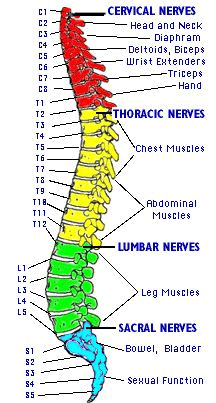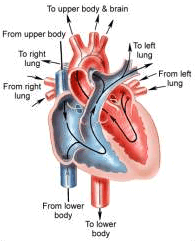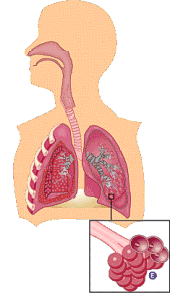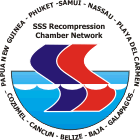|
Introduction
Decompression Illness is a term which includes arterial gas embolism and decompression sickness. These two diseases are described separately below because their presumed causes are different.
Decompression
Sickness (DCS)
 Decompression Sickness (DCS) results from the formation of bubbles in the blood or body tissues, and is caused by inadequate elimination of dissolved gas after a dive or other exposure to high pressure. Decompression Sickness (DCS) results from the formation of bubbles in the blood or body tissues, and is caused by inadequate elimination of dissolved gas after a dive or other exposure to high pressure.
Decompression sickness may also occur with exposure to atmospheric pressure (altitude exposure), as in an altitude chamber or sudden loss of cabin pressure in an aircraft. In certain individuals, decompression sickness may occur from
non-decompression dives, or decompression dives even when decompression procedures are followed meticulously.
Various conditions in the diver or in the diver's surroundings may cause absorption of an excessive amount of inert gas or may inhibit the elimination of the dissolved gas during normal controlled decompression.
DCS can cause any number of complications throughout the body the most
severe being the lodgement of gas
bubbles in the spinal column. The trapped gas bubbles tend
to necratise (choke) the blood supply to the central
nervous system causing paralysis.
Any decompression sickness, although symptoms might be considered
minor by the patient but in actual fact are not (ie joint pain,
numbness & tingling) must be treated immediately by
recompression to prevent a possible worst case scenario
developing.
Arterial
Gas Embolism (AGE)
 Arterial Gas Embolism (AGE) sometimes simply called gas embolism is caused by entry of gas bubbles into the arterial circulation which then act as blood vessel obstruction called emboli. These emboli are frequently the result of pulmonary barotraumas caused by the expansion of gas taken into the lungs while breathing under pressure and held in the lungs during ascent. The gas might have been retained in the lungs by choice (voluntary breath holding) or by accident (blocked air passages). The gas could have become trapped in an obstructed portion of the lungs that has been damaged from some previous disease or accident; or the diver, reacting with panic to a difficult situation may breath hold without realizing it. Arterial Gas Embolism (AGE) sometimes simply called gas embolism is caused by entry of gas bubbles into the arterial circulation which then act as blood vessel obstruction called emboli. These emboli are frequently the result of pulmonary barotraumas caused by the expansion of gas taken into the lungs while breathing under pressure and held in the lungs during ascent. The gas might have been retained in the lungs by choice (voluntary breath holding) or by accident (blocked air passages). The gas could have become trapped in an obstructed portion of the lungs that has been damaged from some previous disease or accident; or the diver, reacting with panic to a difficult situation may breath hold without realizing it.
 If there is enough gas and if it expands sufficiently, the pressure will force gas through the alveolar walls into surrounding tissues and into the bloodstream. If the gas enters the arterial circulation, it will be dispersed to all organs of the body. The organs that are especially susceptible to arterial gas embolism and that are responsible for the life-threatening symptoms are the central nervous system (CNS) and the brain.
If there is enough gas and if it expands sufficiently, the pressure will force gas through the alveolar walls into surrounding tissues and into the bloodstream. If the gas enters the arterial circulation, it will be dispersed to all organs of the body. The organs that are especially susceptible to arterial gas embolism and that are responsible for the life-threatening symptoms are the central nervous system (CNS) and the brain.
In all cases of arterial gas embolism, associated pneumothorax is possible and should not be overlooked.
AGE may develop within minutes of surfacing, causing severe symptoms that must be diagnosed and treated quickly and correctly because the supply of blood to the central nervous system is almost always involved. Unless treated promptly and properly by recompression, AGE is likely to result in death or permanent brain damage.
Safe
Diving Recomendations
If you observe the following recommendations, the chances of getting decompression sickness
are reduced. This does not guarantee however, that you are 100% RISK-FREE. Most often an aggregate of mild symptoms marks the beginning of the Decompression Syndrome. Never neglect to accept this; do not treat
any sign or symptoms with frivolity. If detected early and treated
the chance of having a speedy and 100% satisfactory recovery are dramatically
increased.
DO: Drink plenty of water (prevent dehydration) and dive conservatively within table/computer limits; ascend slowly- no faster than 30 fpm; limit to three (3) dives within twelve hour period, make safety stops after every dive, plan your dives and make sure that you dive your plan.
DON'T: Over exercise, take hot showers or baths after diving; drink alcohol, coffee and sodas immediately before/or after; avoid getting too cold during and after diving; avoid greasy foods; do not fly immediately after a dive.
Signs,
Symptoms & Emergency First Aid
|
The
Signs |
| (1) Blotchy skin rash |
(4) Coughing
Spasms |
| (2) Weakness |
(5) Shortness of
Breath |
| (3) Staggering |
(6) Altered
Mental Status |
|
|
The
Symptoms |
| (A) Pain |
(H) Numbness |
| (B) Extreme
Fatigue |
(I) Dizziness |
| (C) Headache |
(J) Personality
Changes |
| (D) Nausea |
(K) Paralysis |
| (E) Itching |
(L) Reflex
Changes |
| (F) Skin Rash |
(M) Bladder
Problems |
| (G) Restlessness |
- |
|
|
Emergency
First
Aid |
| (A) Check airway, breathing, and circulation (ABCs). |
| (B) Administer 100% oxygen. |
| (C) Place diver in recovery position. |
| (D) Treat for shock. |
| (E) Transport to the nearest Hyperbaric facility ASAP. |
|
|
 Decompression Sickness (DCS) results from the formation of bubbles in the blood or body tissues, and is caused by inadequate elimination of dissolved gas after a dive or other exposure to high pressure.
Decompression Sickness (DCS) results from the formation of bubbles in the blood or body tissues, and is caused by inadequate elimination of dissolved gas after a dive or other exposure to high pressure. Arterial Gas Embolism (AGE) sometimes simply called gas embolism is caused by entry of gas bubbles into the arterial circulation which then act as blood vessel obstruction called emboli. These emboli are frequently the result of pulmonary barotraumas caused by the expansion of gas taken into the lungs while breathing under pressure and held in the lungs during ascent. The gas might have been retained in the lungs by choice (voluntary breath holding) or by accident (blocked air passages). The gas could have become trapped in an obstructed portion of the lungs that has been damaged from some previous disease or accident; or the diver, reacting with panic to a difficult situation may breath hold without realizing it.
Arterial Gas Embolism (AGE) sometimes simply called gas embolism is caused by entry of gas bubbles into the arterial circulation which then act as blood vessel obstruction called emboli. These emboli are frequently the result of pulmonary barotraumas caused by the expansion of gas taken into the lungs while breathing under pressure and held in the lungs during ascent. The gas might have been retained in the lungs by choice (voluntary breath holding) or by accident (blocked air passages). The gas could have become trapped in an obstructed portion of the lungs that has been damaged from some previous disease or accident; or the diver, reacting with panic to a difficult situation may breath hold without realizing it.  If there is enough gas and if it expands sufficiently, the pressure will force gas through the alveolar walls into surrounding tissues and into the bloodstream. If the gas enters the arterial circulation, it will be dispersed to all organs of the body. The organs that are especially susceptible to arterial gas embolism and that are responsible for the life-threatening symptoms are the central nervous system (CNS) and the brain.
If there is enough gas and if it expands sufficiently, the pressure will force gas through the alveolar walls into surrounding tissues and into the bloodstream. If the gas enters the arterial circulation, it will be dispersed to all organs of the body. The organs that are especially susceptible to arterial gas embolism and that are responsible for the life-threatening symptoms are the central nervous system (CNS) and the brain. 